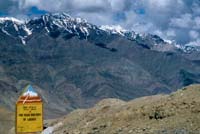 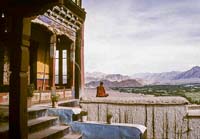    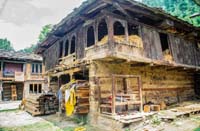   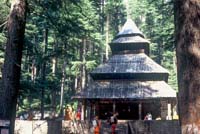    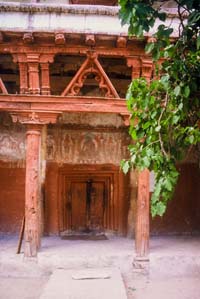 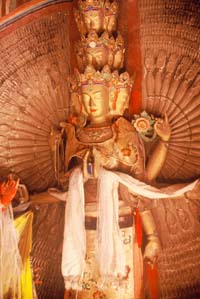 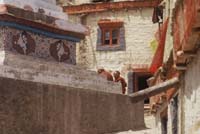  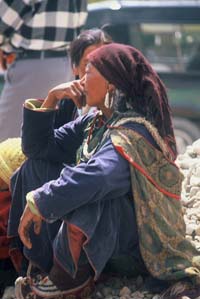  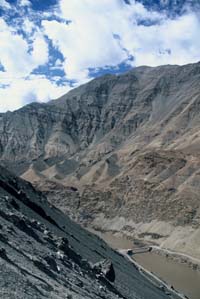 |
Across the Rhotang to Ladakh 19 days from Delhi Day 1: Delhi to Pinjore or Chandigarh The drive north from Delhi takes you through farmland and towns, typical of the plains of northern India. This is the area, known then as Kurukshetra, where the great cosmic battle of the Mahabharata took place long before recorded history. Pinjore garden, built in the 18th century by Fidai Khan, is a beautifully preserved example of a Mogul garden. In a tradition reaching back long before Mohammed to the Hanging Gardens of Babylon, the form for all Islamic gardens is rigidly set by the Koran’s description of heavenly paradise. Religious symbolism, a mystical feeling for certain trees, and, above all, a reverence for water prescribed how these beautiful gardens were built. Hotels – The Pinjore Gardens Tourist Motel is attached to the gardens. Last time I stayed there in 2005 it was simple (no A/C) but clean and cute. Recent reviews on TripAdvisor, however, have been dreadful. Check, and if it’s still not looking good, stay in Chandigarh. Day 2: Pinjore to Simla If you drive to Simla, it’s about 4 hours. For a far better experience, however, send your car and driver ahead and take the 6 hour narrow gage train that leaves from nearby Kalka. For 6 hours, you can follow in the footsteps of countless British Raj officials, board the narrow gauge train for the journey to Simla. Sixty miles across the Shivalik Hills, through103 tunnels, and over 24 bridges, this toy train was one of Viceroy Lord Curzon’s pet projects when he had it commissioned in 1889. Before this, reaching the summer capital had taken days up a torturous winding bullock cart path, dragging tons of cognac, chintzes, and preserves for the gala social season that made Shimla the quintessential hill station. Hotels – As befits the summer capital of the British Raj, there are quite a few wonderful heritage hotels in Shimla. Probably the (current) best are the Cecil Oberoi www.oberoicecil.com and Chapslee, a former maharaja’s palace just outside town. www.chapslee.com Also worth a look is the Spars Lodge www.sparslodge.com , the Marina www.marinashimla.com , Shimla Havens www.shimlahavens.com , the Clarks Hotel www.clarksshimla.com , and the Woodville Palace Hotel www.woodvillepalacehotel.com Day 3, Thursday: Simla Spilling down the ridge of a hill at 6700 ft, Simla was once the prize of the British Raj. Stately Tudor mansions and palaces evoke memories of the glamorous balls and parties attended by Indian Royalty and the English elite during the summer social season. Simla was once where the “A” list of Raj officials, including the Viceroy, spent the May to September hot season, away from the heat of the plains. Take a short sightseeing trip takes us past some of the old buildings and then out to the Himalayan viewpoint at Jako Hill. Late in the afternoon, join the locals walking around the mall – “Malling”, as it’s called here. Day 4: Simla to Kulu It’s a seven hour drive this morning further into the Shivalik hills, winding past peaceful oak and rhododendron forests and along the banks of the Beas River. The beautiful Kulu valley, long and narrow, cradled between the Dhauladhar and Pir Panjal ranges, has been nicknamed “the Valley of the Gods”. Its original name, Kulatapith, means “End of the Habitable World”, but what a stunning “end” it is! Groves of apple and pear trees and deodar cedars line the rushing Beas River. Thousands of ancient wood temples and fabled sacred sites draw devotees here to participate in rituals which are as old as Hinduism itself. Spend the evening exploring Kulu. Hotels – You might want to try the Apple Valley Resorts or the Hotel Vikrant. Not “heritage”, but cute. Day 5: Kulu to Naggar Just outside the town of Kulu is Naggar, the old capital of the Kulu district. Legend tells us that the Kulu Rajas resided here for over 60 generations and we can visit some of the exotic temples which they built. This magnificent part of the valley was also the home of Nicholas Roerich, the great Russian psychic and mystic painter, who lived here from 1928 until his death in 1947. We will visit his home which he named “Hall Estate”. It was from here that Gurudev Roerich, as he was called, created some of his most important paintings dealing with his personal search for Shambhala. There’s a great hotel here – the old Naggar Castle Hotel, a wonderfully old and enchanting palace, built by the Maharajas from gigantic split timbers and granite river rocks. Hotel – Naggar Castle Hotel Day 6: Naggar to Manali After a stop at Jagatsukh to visit some of the old temples, you can drive to the charming village of Manali, situated in the shadow of the Pir Panjal range at the northern most end of the Kulu Valley. Once, when it was known as Danna Bazaar, this town was the last staging point for the caravans before making the arduous crossing into Lahaul and Spiti. It is still the gathering place for many different ethnic groups. Nomadic shepherds such as the elusive Gaddi tribesmen may appear in the bazaar along with Tibetans and various other hill people. In the afternoon, you may want to have a picnic along the banks of the Beas river. Hotel – Try John Bannon’s Guest House Day 7: Manali The Dhungri Temple, dedicated to the Goddess Hadimba, is one of the highlights of the Kulu Valley. Set in the silence of an aromatic deodar cedar grove, this age-worn four story wood pagoda transports the pilgrim back to the mythic age of the Mahabharata when Hadimba was rescued from demons by her husband-to-be, the God Bhima. Visit the Tibetan Monastery where you can learn about the art of making hand knotted carpets. In the afternoon,you might want go up into the hill to visit the quaint town of Old Manali Day 8: Manali to Keylong The drive over the Rotang pass into Leh is, in my opinion, the most spectacular drive in India, and the passes are usually open from July to September. But beware! If you are not acclimatized, it has the potential to kill you. Remember – the rule of thumb is 1 night for every 1000 feet you ascend over 10,000 feet. So, to do this drive, you need to have spent some time at 13,500 feet before you set off. It can be done in 2 gueling 10 hour days, but I prefer a slightly longer, more enjoyable version. As caravans did for hundreds of years, set off this morning to cross the formidable Pir Panjal mountains. These immense mountains halt the monsoon rains so that you leave the richly forested foothills behind and cross into a land of stark and dramatic 20,000 peaks set against indigo skies. Depart Manali at your leisure – the drive to Keylong is only 3 ½ hours. You will be in a four wheel drive, however, much more adept at crossing the 13,050 pass which was so terrifying to the cameleers that they named it Rhotang, “Heap of Dead Bodies”. Keylong is at 10,100 feet and there is some good exploring to be done here, Several monasteries nearby, the most interesting, I think is Khardong. It is home to both nuns and monks and is full of amazing thankas. A bit down the road is an ols palace at Teh. Built in traditional Tibetan style with 108 (a Tibetan sacred number) rooms. Hotels – There are several guesthouses, but it’s been too long since I’ve been there to recommend one. Your tour operator will have the latest and greatest. Day 9:, Keylong to Sarchu It’s easy to see why it was possible to open this awe inspiring route to commercial traffic only a few years ago. The drive today is about 6 hours. The narrow road, high above the Chandra and Bhaga Rivers is a maze of twists and turns around jagged peaks and through barely passable gorges. Perhaps you will see Tibetan Wild Ass and Blue Sheep prized for their pashmina wool. Leave the state of Himachal Pradesh and enter the state of Jammu and Kashmir. Cross the 16,000 ft Baralachla La, the “Crossroads on Summit”, which is the meeting point of routes from Ladakh, Spiti, and the Chandra Valley. You can spend the night, possibly camping, at Sarcu – you will be at 14,500 ft – high enough to kill some one who is not acclimatized. (No joke – I once saw a super-fit 20 something year old guy being carried down, unconscious, from 13,000 ft) Day 10: Sarchu to Leh OK. One killer day – this will be a 10 hour or so drive. But fabulous! This road is famous as one of the highest motorable roads in the world, and this morning you will cross its highest point, the 17,450 ft Taglang La. As you descend into the valley of Ladakh, we will catch our first glimpse of the Indus river, just a small stream here, fresh from the slopes of Mt. Kailash. There are more settlements, now that the altitude has come down to about 12,000 ft. and the remaining drive into Leh is full of small farms, chortens, mani stone walls, and graceful fluttering prayer flags. Hotels – When I was there 8 years ago, the Shambhala and the Lahrimo were very nice, but your tour operator will have the latest. Day 11: Leh Once known as the “Central Asian Diamond” because of its strategic location on the silk road, Ladakh has long been on the cultural crossroads of Asia. Barren and remote, but unforgettably beautiful, this wild land is softened by the warmth of the jovial and amiable Ladakhi people. Our first day here will be free to explore the capital city of Leh, whose name translates as “Oasis”. The architecture here is typical Tibetan in style – straight lines, flat roofs, and dramatic black and ochre colors, giving Ladakh its nickname of “Little Tibet”. Day 12: Hemis and Tikse Ladakh is one of the few remaining places where Tibetan Vajrayana Buddhism is still practiced openly and freely. If you time your trip accordingly, you can attend the great Hemis Festival. This great dance drama takes place every summer and the three day festivities attract crowds of Ladakhis from all over the area. However, at any time – with or without the festival – Hemis is one of the most important monasteries of Ladakh. Eveni if you miss the festival, the visit to Hemis is worthwhile. It’s one of the wealthiest in Ladakh – its hidden location saved it from the marauding Muslims. Stop off at Tikse Monastery which had great views of the Indus River – still but a small stream here. Tikse (it’s a bit of a climb) is famous for its 2 story high Maitreya – the Buddha of the future. Day 13: Leh to Stok The great Indus river is one of the four holy rivers of the Indian subcontinent, flowing first northward and then south from the sacred Mount Kailash. At this point its flow is still gentle and muddy, unlike the torrent that it will become further downstream. You migt want to go rafting trip this morning, floaing past farmlands and villages for a glimpse of rural Ladakhi life. Spend the night in Stok. Day 14: Leh Return to Leh today, where you could visit the Tibetan Handicraft Center and the Museum. This museum holds the best of Ladakhi treasures – Ancient thankas, relics, beautiful silver jewelry, and magnificent peraks, the turquoise and coral headdresses handed down through generations of Ladakhi women. Later, you could have a tour of the Astro Medical Center to learn about the Tibetan system of holistic medicine. This ancient and venerable tradition incorporates elements from the shamanistic Bonpo religion of early Tibet. Day 15: Leh to Alchi Ladakh’s most important monastery in terms of artwork is Alchi, about a 2 hour drive from Leh. At first glance, Alchi is a bit disappointing. But, this collection of low rise buildings contain some of the most important work in the Buddhist art world. Most of the art in Ladakh is religious in nature, not secular – stories of the Buddha’s life, or symbolic expressions of the complicated philosophy and iconography so that even ordinary people without reading skills can be brought into the Buddhist fold. This artistic style was originally brought into this area from Kashmir during the 6th – 11th centuries and from here, it flowed into China via the Silk Road. The Here at Alchi, the best of that sensual and languid style remains in beautifully preserved wallpaintings and wood carvings in the Kashmiri tradition. Day 16,: Lamayuru About 3 hours of driving will land you up at the Isolated and remote Lamayuru gompa. It is the oldest and one of the largest monasteries in Ladakh and belongs to the Kagupa tradition. Its founding reaches back to the age of myth when it was magically built after being prophesied by the arhat Nimagun. Spend the day visiting this spectacular area. The buildings are nestled into the mountains, surrounded by bizarre rock formations which the Ladakhis believe were formed when the waves of the nearby lake were petrified. You can walk out to the enormous Buddha Maitreya carved into the side of a cliff. Spend the night at the nearby village. Day 17: Leh On the way back to Leh, you may want to visit the Likir Gompa. This monastery belongs to the Gelugpa tradition and its present Rimpoche is the younger brother of His Holiness, the Dalai Lama. The largest religious school in Ladakh, there are about 100 monks in residence. The atmosphere here is perfect – vibrant yet serene and peaceful. Quiet shadowy light, pungent incense, and smoke from hundreds of silver butter lamps give this gompa an aura of arcane mystery Day 18: Leh Have a free day in Leh to relax or finish up sightseeing. There are many interesting walks and hikes through out he area. Or, perhaps you could find an artist to instruct you in the complex and painstaking method of thanka painting. Perhaps you could seek out an herbalist or an amchi – a shamanistic healer. Day 19: Leh to Delhi Fly back to Delhi this morning. |
